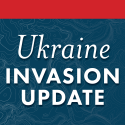Russian Offensive Campaign Assessment, May 11
May 11, 2022 - ISW Press
Russian forces did not make any significant advances anywhere in Ukraine on May 11, and Ukrainian forces took further ground northeast of Kharkiv. The Ukrainian counteroffensive north of Kharkiv City has forced Russian troops onto the defensive and necessitated reinforcement and replenishment efforts intended to prevent further Ukrainian advances towards the Russian border. Russian efforts along the Southern Axis and in Donetsk and Luhansk Oblasts remain similarly stalled, and Russian forces have not made any significant gains in the face of continued successful Ukrainian defenses.










